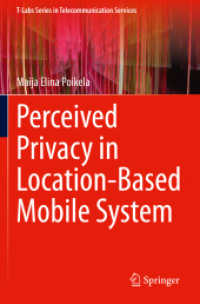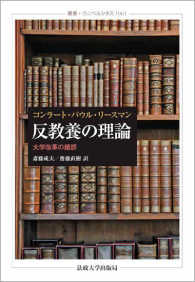- ホーム
- > 洋書
- > ドイツ書
- > Mathematics, Sciences & Technology
- > Earth Science
Full Description
This book offers a rich, cross-disciplinary examination of military, modern, and industrial heritage through fresh perspectives on interpretation, reuse, and technological integration. Structured into five focused sections, it explores strategies for reimagining defensive structures, institutional architecture, and post-industrial landscapes throughout Europe. Case studies range from fortified complexes and decommissioned prisons to socialist-era sports halls and heritage rail stations, revealing the cultural layers and design challenges inherent in their protection and renewal. This book highlights the application of advanced digital methodologies—such as GeoAI mapping, HBIM systems, and cost-effective 3D modelling—to enhance understanding, planning, and stewardship. It also investigates material conservation and the intersection of modern heritage with contemporary energy and sustainability goals. Emphasizing inclusive narratives, socio-cultural relevance, and innovation in practice, this book serves as a vital reference for designers, conservationists, policy-makers, and academics committed to preserving the character and meaning of built environments while adapting them for future needs.
Contents
Interpretation of the military cultural landscapes of the ICOMOS guidelines on Fortifications and Military Heritage (2021).- The architectural promenade of the walls of Pisa.- Heritage is plural. Recovery and adaptive reuse of the Polveriera Castelfidardo in Ancona.- The SOSLabs Project. An Integrated Approach for the reuse of Historical State-Owned Heritage.- Knowledge and Conservation of Historic Prisons built in fragile territories: the case of the Avalos Complex in Procida.- Military Heritage Conservation and Regeneration: A Categorisation Approach to Identify the Most Challenging Military Heritage Typologies in the UK.- Military Digital Landscapes. An overview of GeoAI methodologies for Built and Landscape Heritage documentation.- Multisource approach in the 3D documentation of an alpine defensive system: the Vallo Alpino in the Gardetta Plateau area (CN).- Use of Low-Cost Spherical Camera for the Cultural Heritage 3D model.- Raumbuch and HBIM: an integrated approach for the redevelopment of the "Palazzo de La Vallée" in Cagliari.- Conservation and restoration in the 21st century. Reflections on the cultural significance, identity, and authenticity of cultural heritage.- The preservation of typological features of asylum architecture: from decommissioning to reuse.- Can Romanian socialist sports halls be historical monuments?.- To bring you the monument itself". Bogdan Bogdanović's memorials in Serbia caught between cultural value and denial.- Valorisation of ex-Yugoslav dissonant heritage from transnational perspectives.- Towards the adaptive reuse of town centres buildings at scale in Ireland: Introducing the Trebuchet project.- Modern materials; A legacy from 20th Century Italy.- Preventive Conservation of Concrete University Buildings: A Study of the Conservation Plan for the Vilanova Artigas Building.- An Archaeology of Architecture for the Contemporary Architecture.- Modern Heritage Preservation in the context of Energy Transition. 20th Century School Architecture: a Living Heritage.- THE INDUSTRIAL HERITAGE UNDER THE THREAT OF "REUSE".- Contextually Sensitive Analysis of the Social Sustainability in the Industrial Heritage Quarter Regeneration.- Knowledge for the restoration of industrial-archaeological heritage: the case of the former Garofalo pasta factory in Gragnano (NA).- New Design in Heritage Rail Stations: Balancing Conservation and Modernization.








